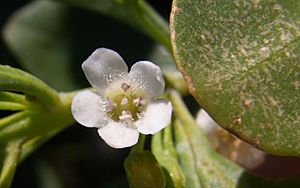Myoporum boninense facts for kids
Quick facts for kids Myoporum boninense |
|
|---|---|
 |
|
| Myoporum boninense at Bilgola | |
| Scientific classification | |
| Genus: |
Myoporum
|
| Species: |
boninense
|
Myoporum boninense is a cool plant that belongs to the figwort family, also known as Scrophulariaceae. It's a type of shrub, which means it's a woody plant smaller than a tree. This plant has thick, shiny leaves that feel a bit fleshy. It grows pretty white flowers in small bunches and later produces shiny fruits that are light purple or lilac. You can find Myoporum boninense growing along the coast in places like New South Wales and Queensland in Australia. It also lives on islands in the northwest Pacific Ocean.
Contents
What Myoporum boninense Looks Like
Myoporum boninense is a shrub that can grow in different ways. Sometimes it lies flat on the ground, which is called prostrate. Other times, it stands up straight (erect) or spreads out wide. This plant can grow up to about 2 metres (7 ft) tall.
Unlike some other plants in its group, it usually doesn't have small, wart-like bumps on its stems. Its leaves grow one after another along the stem. They are usually thick and often feel fleshy. The leaves are about 12–70 millimetres (0.5–3 in) long and 5.5–36 millimetres (0.2–1 in) wide. They are shaped like an egg, sometimes narrower at the bottom. Both sides of the leaves are shiny and smooth, meaning they have no hairs (glabrous).
Flowers and Fruits
The flowers of Myoporum boninense grow in groups of 1 to 8. They appear where the leaves meet the stem. Each group of flowers is on a stalk about 5–15 millimetres (0.2–0.6 in) long. Each flower has 5 sepals, which are like small leaf-like parts that protect the bud. It also has 5 white petals. These petals join together at their base to form a tube.
The flower tube is about 2–4 millimetres (0.08–0.2 in) long and has tiny hairs inside its upper part. The tips of the petals are about 2–3 millimetres (0.08–0.1 in) long and are also hairy on the inside. Inside the flower, there are 4 stamens, which are the parts that produce pollen.
This plant usually flowers in spring and summer. After the flowers, it produces fruits called drupes. These fruits are round, about 5–10 millimetres (0.2–0.4 in) across. They are shiny pink, but sometimes they can be cream-colored with purple spots.
Plant Names and History
The scientific name Myoporum boninense was first officially described in 1918. This was done by a scientist named Gen-ichi Koidzumi in a publication called the Botanical Magazine (Tokyo). The second part of its name, boninense, tells us where it was first found. It refers to the Bonin Islands.
Different Types of Myoporum boninense
There are two main types, or subspecies, of Myoporum boninense:
- Myoporum boninense Koidz. subsp. boninense: This type grows on the Bonin Islands, which are southwest of the main islands of Japan. It also grows on the Mariana Islands. You can find it on coral limestone and sand very close to the sea.
- Myoporum boninense subsp. australe Chinnock: This type is found in New South Wales and Queensland, Australia. It often grows flat on rocky areas along the coast. It can also be a taller shrub found along river mouths (estuarine creeks).
Where This Plant Lives
Myoporum boninense likes to live in coastal areas. This means it often grows very close to the sea. You can find it in eastern Australia and on smaller islands to the north of Australia.
How People Use Myoporum boninense
Traditional Uses
Aboriginal people used the fruits of Myoporum boninense to add flavor to their cooked foods. They usually didn't eat the fruits raw because they were considered too bitter.
Garden Uses
This plant is also used in gardens, especially as a ground cover. It looks best when it is trimmed regularly.

